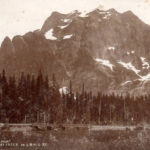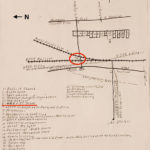All Over The Map: Political shenanigans at the Big Four Inn
Sep 27, 2019, 10:48 AM
A depot once stood in a part of what’s now Lake Stevens east of Everett in Snohomish County. From that depot, from the teens to the 1930s, passengers could ride by rail to the old Big Four Inn, now site of a popular trailhead on the Mountain Loop Highway east of Granite Falls – and once the stage for local political scandal.
The separate town of Hartford, also known as Hartford Junction, was northeast of the lake, and a little south of where Highway 92 now runs. Founder James Van Horn named the town after wife Kate’s former home of Hartford, South Dakota. The South Dakota “Hartford” was named after Hartford, Connecticut; and that Hartford was named after Hertford in the UK; in Anglo-Saxon, “Hertford” translates as “deer crossing.”
The rail line originally dates to the early 1890s when it was called the “Everett & Monte Cristo Railway.” A portion eventually became known as the “Hartford & Eastern Line,” when it was operated by the famous Rucker brothers of Everett from 1915 to the early 1930s.
Cruising with the ghosts of Sunset Highway
Other than a few road names, there’s not much evidence of Hartford ever existing. There’s nothing left from the depot or other elements of the railroad, though there is a nice commemorative sign that an Eagle Scout created 50 years ago.
The rails went east from Hartford more than 40 miles along the South Fork of the Stillaguamish River to the old mining town of Monte Cristo. It was originally used for logging and silver mining, but around 1915, it morphed into a combination logging and tourist line, with tourists riding the rails in modified gas-powered coaches (with flanged steel wheels in place of rubber tires).
Tourists headed for the Big Four Inn, a 50-room vacation resort opened in 1921 by the Rucker brothers. Big Four had a three-story lodge with a giant fireplace, plus cabins, tennis courts, horseback riding and a nine-hole golf course. Regular buses and cars eventually took over much of the transportation duties; the rails were removed in the mid 1930s, and the Mountain Loop Highway took the place of the train.
The Big Four Inn was unoccupied when it burned to the ground in September 1949. The old fireplace survived, and is still there next to the parking lot for the trail that goes to the dangerous ice caves.
Scandal at the Big Four Inn
A decade before the inn burned, it played a part in one of the bigger political dust ups of pre-World War II Seattle: the so-called “Big Four Inn Caper” of 1941.
Seattle Mayor Earl Millikin camped out at Big Four Inn for several days that summer, ostensibly for health reasons, but more likely because he was trying to force the City Council to confirm Millikin’s unpopular nominee for police chief.
It’s a complicated story, but a vacancy on the City Council meant that Millikin’s absence could have prevented Seattle City Councilmember (and Acting Mayor) David Levine from blocking Millikin’s nominee. However, Levine figured out what was up, and then Levine also traveled east to take up residence at Big Four Inn. He was joined at the mountain resort by three other council members, which effectively blew up the whole police chief issue and deflected Millikin’s political joust. After the fracas, neither Milliken nor Levine got their first choice for chief.
And people say politics in Seattle is kooky nowadays.
Later that same year of those political shenanigans – 1941 – right after Pearl Harbor was attacked, the owners of Big Four Inn offered itself up as a shelter for up to a thousand women and children made homeless if Seattle were to be bombed. That didn’t happen, of course.
But, by September 1942, Big Four Inn had found another wartime use. It became a training camp for the US Coast Guard, with up to 500 men at a time housed there, building up their strength by chopping their own firewood and doing other exercises in the fresh mountain air.
By the summer of 1945, before the war was even over, Big Four Inn had reverted to civilian use and things were back to business as usual until the fire in 1949.
Big Four Inn was named for 6,120 foot-tall Big Four Mountain, which served as a picturesque backdrop for the resort, and at the base of which the dangerous ice caves formed. The name “Big Four” (which is often seen on old documents spelled out as “Big 4”) comes from an actual large Arabic numeral “4” that many people say is (or was) visible on one side of the mountain. The “4” is a natural phenomenon created by a combination of dark rock outcroppings and accumulations of snow in the gaps between.
After the fire, the land where Big Four Inn stood for 28 years was eventually purchased by the federal government and became part of what’s now the Mt. Baker-Snoqualmie National Forest. It’s unknown if any Seattle elected officials have tried hiding there lately.
EDITOR’S NOTE: Special thanks to Cyndi Fraser of the Lake Stevens Historical Museum for enthusiastic help with research for this story and for sharing some great photos.




















